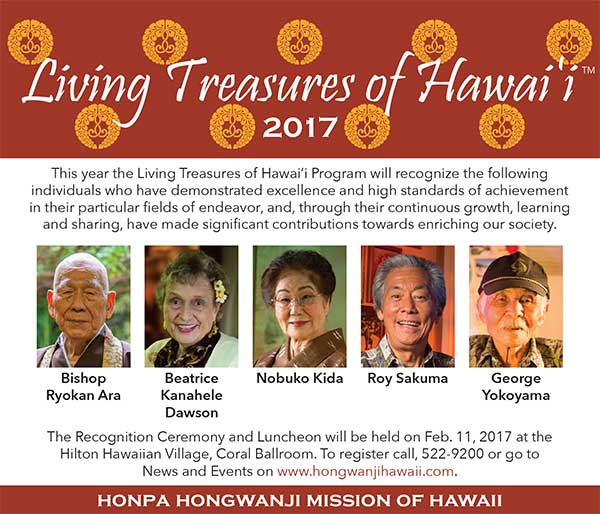
NEWS RELEASE – for immediate release
January 3, 2017
Contact:
Arthur Nakagawa 808-522-9200
hqbus@honpahi.org
HONOLULU, Hawaii – Whether through flowers, music, philanthropy, or preservation of culture and history, this year’s Living Treasures of Hawaii honorees have enriched our community through their unique talents and selfless giving.
The five individuals chosen as this year’s Living Treasures have made an impact on those around them and continue to shine as an example of generosity and benevolence.
The 42nd Living Treasures of Hawaii Recognition Program and Gala Luncheon will be held on Saturday, February 11, 2017, 11 a.m. in the Coral Ballroom at the Hilton Hawaiian Village Waikiki Beach Resort.
The first “Living Treasures of Hawaii” honor began in 1976 through the Honpa Hongwanji Mission of Hawaii as a way to recognize and celebrate individuals who have demonstrated excellence and high standards of achievement in their particular fields. The honorees are also acknowledged for their continuous growth, learning and sharing, which have made significant contributions towards enriching our society.
The following individuals have been chosen as the 2017 Living Treasurers of Hawaii:
BEATRICE “BEADIE” KANAHELE DAWSON
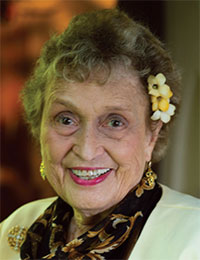 Beatrice “Beadie” Kanahele Dawson is a woman who has committed much of her life to serving others. Recognized as a devoted mother, community leader, Hawaiian activist, business executive and attorney, Beadie has always welcomed challenges. In the years since she passed the Hawaii Bar in 1981 at the age of 52, Beadie has used her law degree to fulfill her passion for helping others. This passion is what led her to take on one of the biggest challenges of her life: seeking justice for the beneficiaries of Kamehameha Schools Bishop Estate amidst the worst trustee mismanagement controversy in the schools’ century-old history.
Beatrice “Beadie” Kanahele Dawson is a woman who has committed much of her life to serving others. Recognized as a devoted mother, community leader, Hawaiian activist, business executive and attorney, Beadie has always welcomed challenges. In the years since she passed the Hawaii Bar in 1981 at the age of 52, Beadie has used her law degree to fulfill her passion for helping others. This passion is what led her to take on one of the biggest challenges of her life: seeking justice for the beneficiaries of Kamehameha Schools Bishop Estate amidst the worst trustee mismanagement controversy in the schools’ century-old history.
Beadie has served as an officer and director of the Native Hawaiian Bar Association and the Native Hawaiian Legal Corporation and is the current president of the Social Science
Association, an organization of Hawaii’s most prominent leaders, established in 1882. She is also an active board member of the Friends of the Medical School at the John A. Burns School of Medicine and contributes much time to the Ka Huli Ao Center for Excellence in Native Hawaiian Law at her alma mater, the William S. Richardson School of Law at UH.
Among her greatest accomplishments has been the restoration of Iolani Palace through the Friends of Iolani Palace, an organization of which Beadie was a founder. This remarkable achievement, among her numerous contributions over the years, will have a lasting impact on the community for generations to come.
BISHOP RYOKAN ARA
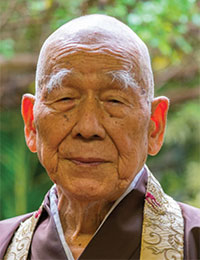 Promoting friendship and understanding between Japan and Hawaii has been a constant motivation behind the many significant contributions from Bishop Ryokan Ara.
Promoting friendship and understanding between Japan and Hawaii has been a constant motivation behind the many significant contributions from Bishop Ryokan Ara.
Bishop Ara, whose training for the priesthood began at age 10, has used his talent as an accomplished artist and calligrapher to introduce Japanese culture into the local community through classes in calligraphy, flower arranging, Japanese-style painting and tea ceremony. These classes led to the establishment of the Hawaii Bijutsuin, or the Hawaii Institute of Arts. Bishop Ara was instrumental in establishing the Hawaii Ichigu Kai, a service organization based on Buddhist philosophy and teachings. A major undertaking of the Hawaii Ichigu Kai was the audio recording of 100 Issei (first generation immigrant Japanese) sharing life stories. These valuable recordings were then donated to the Bishop Museum.
In 1987, Bishop Ara initiated the Honolulu Toro Nagashi (floating lantern) ceremony on the Ala Wai Canal. The ceremony was held annually on the anniversary of the end of World War II in the Pacific to pray for peace and to honor the memory of those who died as a result of war. In an effort to preserve the stories of courage and sacrifice from the dwindling number of Nisei who fought for America in WWII, Bishop Ara put together a team of volunteers to interview the soldiers and has published a series of books “Japanese Eyes, American Heart” Volumes I, II, and III. Volume IV is currently in production. Bishop Ara has raised thousands of dollars to publish these books and donate them to schools and libraries so that future generations may learn about the character values that contributed to the success of the Nisei.
NOBUKO KIDA
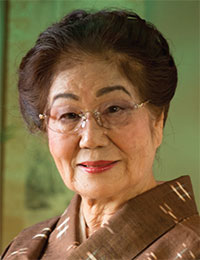 Nobuko Kida has dedicated her life to serving as a bridge between Japan and Hawaii through ikebana, or flower arranging. For more than 50 years, Nobuko has been honing her craft and teaching others this beautiful art form which began in the 6th century.
Nobuko Kida has dedicated her life to serving as a bridge between Japan and Hawaii through ikebana, or flower arranging. For more than 50 years, Nobuko has been honing her craft and teaching others this beautiful art form which began in the 6th century.
Nobuko began her studies of the Ikenobo style of Ikebana at age 15 in her homeland of Okinawa. Shortly after arriving in Hawaii with her husband in 1978, Nobuko began arranging flowers for temple services and functions. This led to teaching classes to temple children. However, the popularity of her style of encompassing both the traditional and modern quickly spread and Nobuko eventually became one of the founding members of the Ikenobo-Ikebana Society of Hawaii. Now her arrangements and those of her students bring the joy of flower arranging to temples, schools, hospitals, government offices, local festivals, consulates and community centers across the state.
Her gift of ikebana has been recognized with a Lifetime Achievement certificate from the 45th Headmaster Sen’ei Ikenobo and the “2014 Uchinanchu of the Year” from the Hawaii United Okinawa Association.
Nobuko actively updates her skills by working with professors from Japan and regularly attending workshops in Japan. To this day, she continues to generously give of her talent through displays and classes with the hope this may serve as a way to draw people together in peace and harmony.
ROY SAKUMA
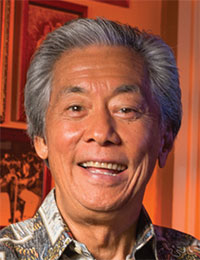 For more than 30 years, Roy Sakuma has devoted himself completely to teaching others to understand, appreciate and play the ukulele.
For more than 30 years, Roy Sakuma has devoted himself completely to teaching others to understand, appreciate and play the ukulele.
After dropping out of high school at age 16, Roy was inspired to learn the ukulele after hearing a song by Herb “Ohta-san” Ohta, whom he sought him out to become his student and then set out to become the greatest ukulele player in the world. Roy discovered his true calling after he was asked by Ohta-san to teach his classes while he toured in Japan.
In 1974, he opened the Roy Sakuma Studio. Today, there are four locations with 30 instructors, all of whom are former students. Thousands have learned the ukulele through Roy’s studios over the years. Among the most notable, Israel Kamakawiwo’ole and Jake Shimabukuro.
To further promote the irresistible charm of this uniquely Hawaiian instrument, Roy started the Ukulele Festival at Kapiolani Park. The first festival in July 1971 featured 50 of his students. Today, the annual Ukulele Festival is the largest in the world, bringing in thousands of spectators to see ukulele performers from all over the globe.
Together with his wife, Kathy, Roy founded the Ukulele Festival Hawaii, a non-profit organization that coordinates the event to ensure it continues for future generations, helps sponsor other festivals in Hawaii, and funds scholarships for high school students planning on attending college.
GEORGE YOKOYAMA
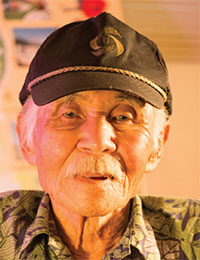 While the number of people on Hawaii Island touched by his work delve into the thousands, most probably have no idea how George Yokoyama has impacted their lives.
While the number of people on Hawaii Island touched by his work delve into the thousands, most probably have no idea how George Yokoyama has impacted their lives.
Even today at age 90, George continues to use the power of words and prose to better the lives of the economically disadvantaged. George uses his skills as a prolific grant writer to secure funding through the Hawaii County Economic Opportunity Council (HCEOC). Total numbers are difficult to tally, but estimates have George acquiring hundreds of millions of dollars through the grants he has secured over the last 45 years. Serving as Executive Director of the HCEOC for a time, he did much of his grant writing outside of regular work hours.
The projects that have benefited from George’s efforts are wide and varied, ranging from job training for welfare recipients, to a Cultural Center in Hilo to create jobs and showcase Hawaii’s multicultural and multiethnic populations working in harmony, to a dialysis machine for rural Ka’u dialysis patients.
George admits he was a juvenile delinquent who started smoking at age 13, but turned his life around after being drafted and serving 10 years in the Army during World War II. Later, even without a high school diploma, George was able to get accepted into and graduate from the prestigious Sophia University in Tokyo. A grant writing seminar then led to his life’s work to combat poverty.
He recently wrote and published a book entitled A Memoir of Fighting Poverty in Paradise, which shares insight into his passion for helping the poor and also serves as inspiration on how others can make a difference in our communities.
For more information on Living Treasures of Hawaii, please visit https://hongwanjihawaii.com/living-treasures.
See also: Living treasures of Hawaii, a Honolulu Star-Advertiser article, by Pat Gee January 7, 2017
